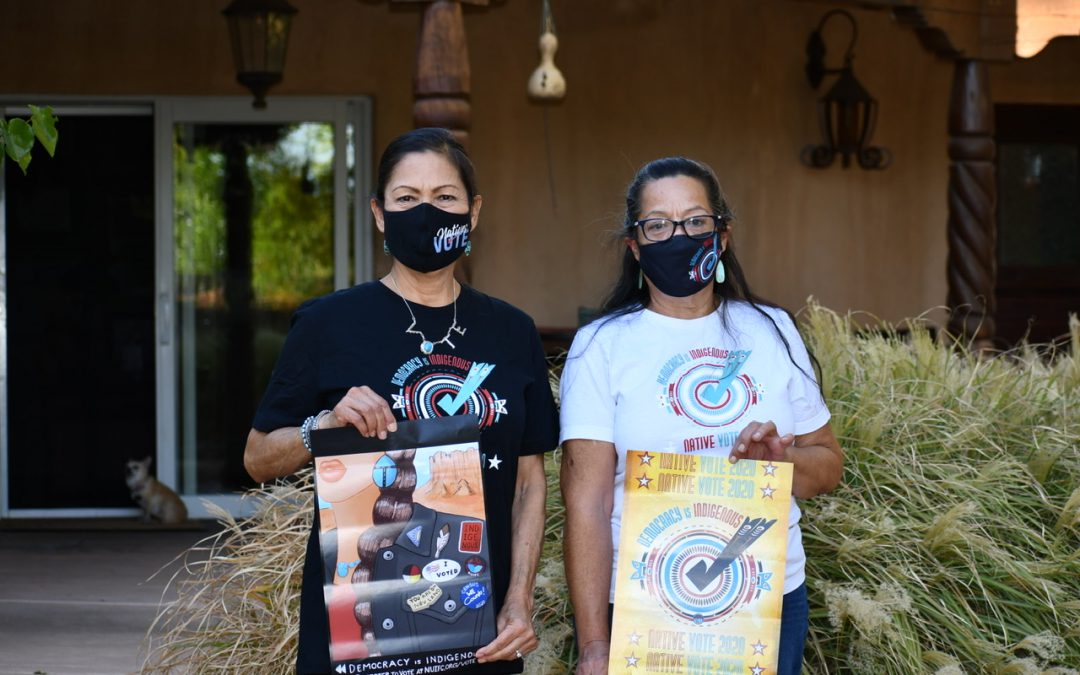WASHINGTON — Native Americans nationwide have long faced hurdles in casting ballots, leaving them with one of the lowest voter turnout rates of any racial or ethnic group in the U.S., even as their numbers have grown.
About 34% of voting eligible Native Americans aren’t registered to vote, according to the National Congress of American Indians. The same organization said that American Indian and Alaska Native registered voters actually cast ballots at 1 to 10 percentage points below the rates of other groups.
Meanwhile, they are a rapidly growing population, increasing from 4.1 to 5.2 million between 2000 and 2010, meaning they could have a measurable influence in several states.
Adding the impact of the pandemic on Native Americans, who are 3.5 times more likely than white Americans to contract coronavirus, to the historically low turnout rates has meant that Native American advocacy groups and politicians nationwide say they must work harder than ever to turn out voters.
Wisconsin
Wisconsin’s Native American population of 50,422 could play a key role in the presidential election; President Donald Trump won Wisconsin by only 22,748 votes in 2016.
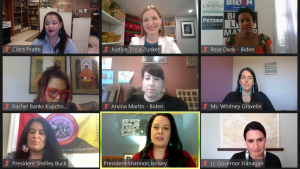
Native women leaders, including Wisconsin congressional candidate Tricia Zunker, attend a Biden-Harris talking circle on Zoom in September. (Courtesy: Tricia Zunker)
“I do think that the native vote can make all the difference in making Wisconsin blue,” said Tricia Zunker, Ho-Chunk Nation Supreme Court associate justice and candidate for Wisconsin’s 7th Congressional District. “The native vote is a powerful voice.”
But that change might be hampered by barriers like a lack of transportation to polling places and a lack of broadband access that obstructs access to voting information, Zunker said.
She also said Native Americans’ low level of trust in the government could cause them to choose not to participate, thinking their voices don’t matter.
“When there is an indigenous voice at the table, the conversation changes,” she said.
Native American voters, Zunker said, vote for candidates who will work to strengthen tribal sovereignty and protect treaty rights, provide adequate health care access, improve the environment for future generations and expand economic development for tribal communities.
Minnesota
Hillary Clinton won Minnesota by 44,765 votes in 2016, less than the state’s Native population of 53,168. About 4% of eligible voters in Minnesota are Native Americans.
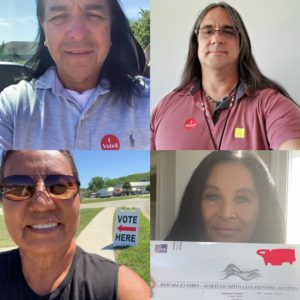
The Prairie Island Indian Community Tribal Council, including Secretary Johnny Johnson, Treasurer Michael Childs Jr., Vice President Lucy Taylor and President Shelley Buck vote early in the 2020 election. (Courtesy: Prairie Island Indian Community)
Shelley Buck, president of the Prairie Island Indian Community, attended a Biden-Harris campaign event hosting Native women leaders in September. “We’ve never had anything like this,” she said. Candidate outreach to Native Americans is rare, she said, but she wants to see more politicians bring tribal leaders to the table.
“The only time we see some of the politicians is around election time,” she said.
Buck’s community has consistent Election Day traditions, starting with Election Day breakfast in the morning. Because most who live on the reservation vote in the same place, Buck and her council then provide a shuttle that takes seniors to the polling place. A polling place or ballot dropoff on the reservation would make voting more accessible, she said.
For many tribal communities, the nearest post office is 10 to 30 miles away, said Daniel Mccool, a political science professor at the University of Utah. “Voter costs are just skyrocketing for Native Americans under COVID,” he said.
One of the issues Buck’s community cares most about, Buck said, is teaching an accurate history of Native Americans in the state. “Americans then aren’t surprised in their 40s and 50s to find out some of the horrors that happen to our people right next door to them,” she said.
As a tribal community that lives near a nuclear power plant, a river that regularly floods the reservation and a train that blocks their road, protecting the land is another issue they care about deeply, she said.
Buck said she’s registering community members at a higher rate this election. She’s noticed youth in the tribe are becoming increasingly energized to vote. “They’re gonna make a lot of change,” she said.
Arizona
Arizona, where 6% of eligible voters are Native American, has the third highest number of Native Americans in the nation. At 286,680, they represent more than three times Trump’s margin of victory in 2016.

Gabriella (right) at the first ever campaign sign giveaway on the Tohono O’odham reservation, with founders of Indivisible Tohono, a grassroots community org she also cofounded. (Courtesy: Gabriella Cázares-Kelly)
Gabriella Cázares-Kelly, candidate for Pima County Recorder, remembers the challenges she faced three years ago when she tried to register young voters at Tohono O’odham Community College, where she worked as academic advisor. Instead of taking a few days to get 300 students registered, it took months.
The main obstacle in filling out forms was physical address questions, Kelly said, because many tribal communities don’t use house numbers and street names, instead using a set of directions. The address for the college, for instance, is highway 86 milepost 125 and a half. With a nonstandard address, tribal members have to register by mail instead of online, but Kelly said paper forms aren’t available in usual places like post offices or libraries.
The confusion was not addressed by Pima County election officials, Kelly said.
“We really need messaging explaining that if you simply put the name of your community, then that is absolutely acceptable.”
Since the community’s ballot dropoffs aren’t within walking distance, neighbors used to collect ballots and deliver them for one another. Now Arizona bans ballot collection, even though it’s become more needed during the pandemic.
And ballots mailed from reservations often take longer to arrive at election offices, said Jean Schroedel, author of Voting in Indian Country: The View from the Trenches. In some tests Schroedel conducted, it took six days for a ballot to arrive at an election office, while in others ballots never arrived.
“For people who look like me, people come from communities like I do, [voting] can be an act of defiance,” Kelly said. “But it’s just an emotional task that we have to carry out.”
New Mexico
New Mexico’s Native population is 219,237. Clinton beat Trump in the state in 2016 by about 70,000 votes. About 11% of New Mexico’s eligible voters identify as Native Americans.

New Mexico Rep. Deb Haaland (left) and Americans for Indian Opportunity Executive Director Laura Harris try to get Native Americans to vote. (Courtesy: Americans for Indian Opportunity)
Laura Harris, executive director at Americans for Indian Opportunity, said that some Native American communities in New Mexico lack access to close polling locations. She said there should be more coordination between county clerks and tribal government, so that there’s a sufficient number of polling places.
In past years, her group used mobile voting, taking an RV to reservations throughout New Mexico. But that wasn’t an option this year because of COVID-19.
“You want to get on the phone with these tribal leaders and say, ‘Open up your polling site.’ But then, how can you do that when our population is dying at much higher rates?” she said.
Rather than in-person rallies to engage voters, Harris’s team distributes meals along with voting information to families in need during the pandemic.
Washington
With a population of 80,274, Native Americans in Washington make up 3% of the state’s eligible voters.
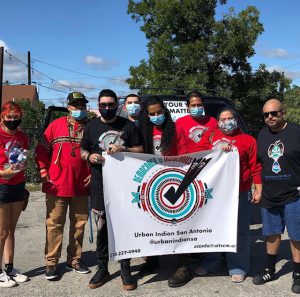
National Urban Indian Family Coalition staff conduct voter outreach in urban areas such as San Antonio, Texas. (Courtesy: National Urban Indian Family Coalition)
Rio Fernandes, communications director at the National Urban Indian Family Coalition, said there aren’t enough efforts to reach out to the 67% of Native Americans who live in metropolitan areas rather than reservations. His organization has worked to fill those gaps by partnering with advocacy groups throughout the country.
Poverty makes it difficult for Native Americans in cities like Seattle to vote. Native Americans comprise 7% of the Seattle homeless population, despite being only 1% of the city’s population.
“There’s a really well-proven and very understandable apathy and lack of belief that the government cares about Indian people, that the government is responsive to the issues that we care about and that the government will be responsible for us and be good partners in the work that we’re trying to do,” he said.
Montana
The 64,643 Native Americans in Montana make up 7% of the state’s eligible voters.
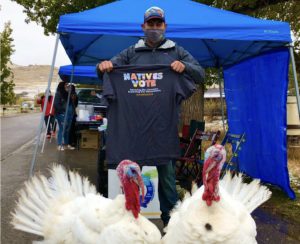
Tyrel Fennel, Western Native Voice Regional Organizer in Flathead Reservation, said he had quite a few different animals including deer, geese, ducks and turkeys show up while he was set up registering voters. They later held a meme contest, where the winning caption was “Natives Vote, Turkeys Tweet.” (Courtesy: Western Native Voice)
Marci McLean, executive director at Western Native Voice, hired 40 additional staff members in the past three weeks to increase voter engagement.
McLean said some Montana tribes, like those on the Northern Cheyenne Indian Reservation and the Blackfeet Indian Reservation, have to travel 70 miles to reach a county office where they can register to vote.
In March, Western Native Voice, represented by the Native American Rights Fund, challenged the Montana Ballot Interference Prevention Act, a law that imposed restrictions on ballot collection efforts critical to Native Americans on reservations. Native American community organizers often collect and transport ballots to election offices, so the lawsuit argued that banning ballot collection would make voting inaccessible. The law was struck down on Sept. 25.
On average, Native Americans travel 29 miles to vote, said Natalie Landreth, Native American Rights Fund senior staff attorney.
Ballot collection is also critical with many tribal nations sheltering in place because of COVID-19. Native Americans account for 12% of coronavirus cases in Montana, according to the state’s Department of Health and Human Services, despite only comprising 6% of the state’s population.
“When we have to choose between voting and our lives, of course we’re going to choose our lives,” McLean said.
There have been pushes by legislators to improve Native American voting rights in recent years. New Mexico Rep. Ben Luján and Sen. Tom Udall sponsored the Native American Voting Rights Act of 2019 to expand voter registration sites, increase polling site accessibility, require approval for polling place changes, validate tribal identification and expand bilingual voting accessibility. The bill would establish a task force to increase voter outreach, education, registration, turnout and accessibility in Native American communities.
“Congressman Luján worked to include key provisions of NAVRA in both versions of the Heroes Act to remove obstacles to voting safely during the public health crisis. He is very encouraged by the strong bicameral support of his Democratic colleagues for NAVRA and protecting the voting rights of every American,” said Adán Serna, Press Secretary for Luján.
James Tucker, voting rights counsel for the Native American Rights Fund who partnered with the congressmen on the bill, expects the bill to pass early next year.
“It’s not going to eliminate all voting barriers and obstacles in Indian country,” he said. “But it’s going to remove a large part of them, many of which are very easy to address.”

